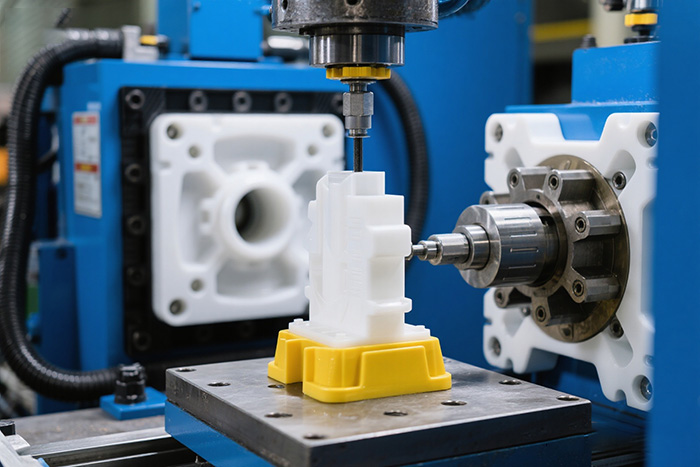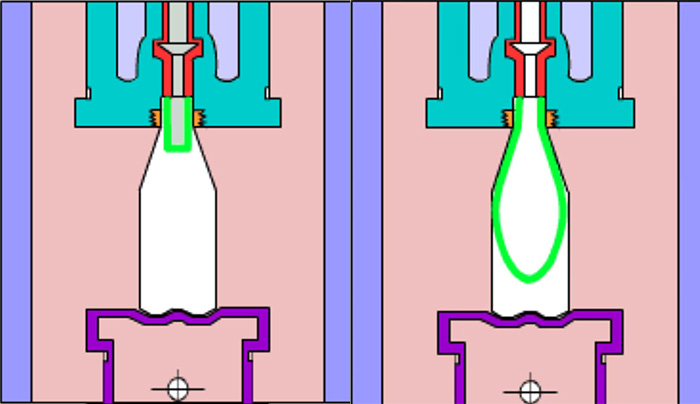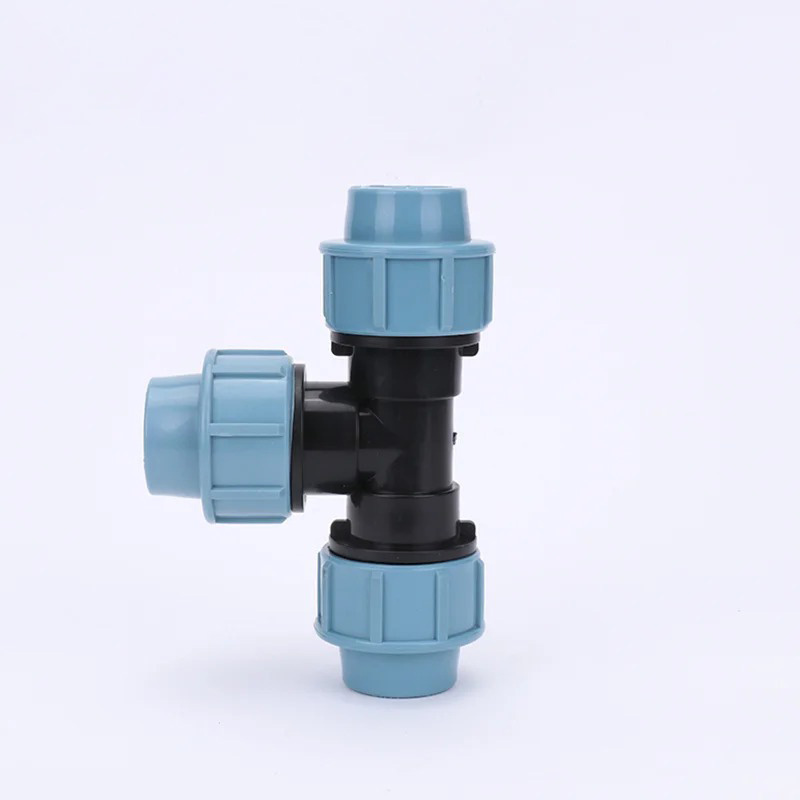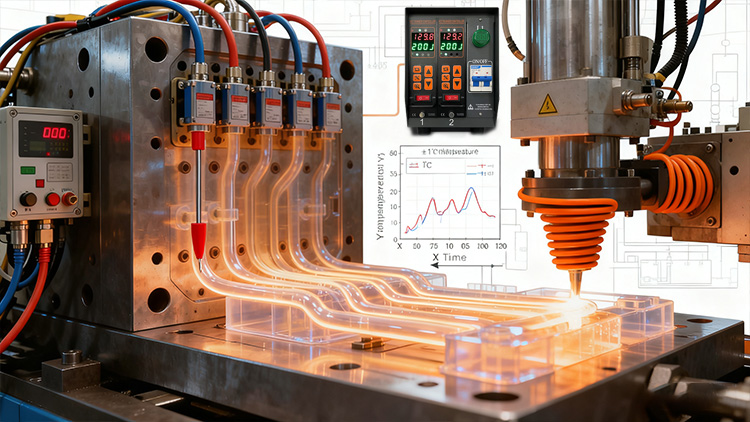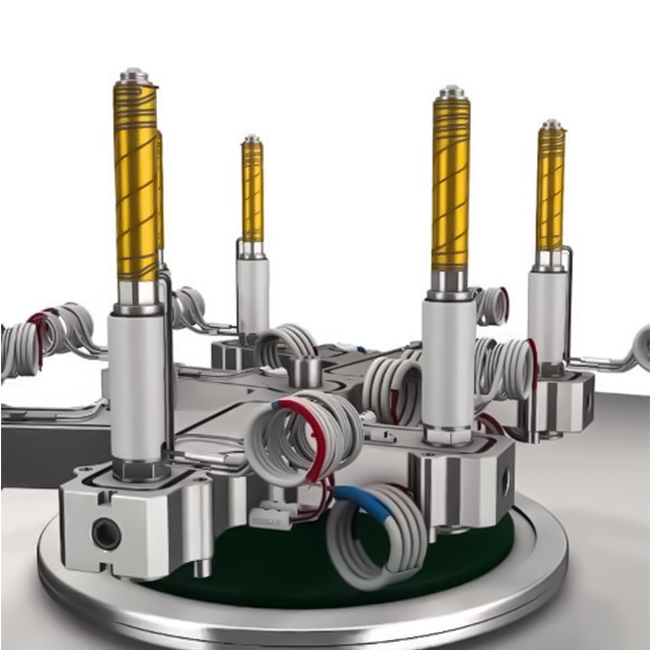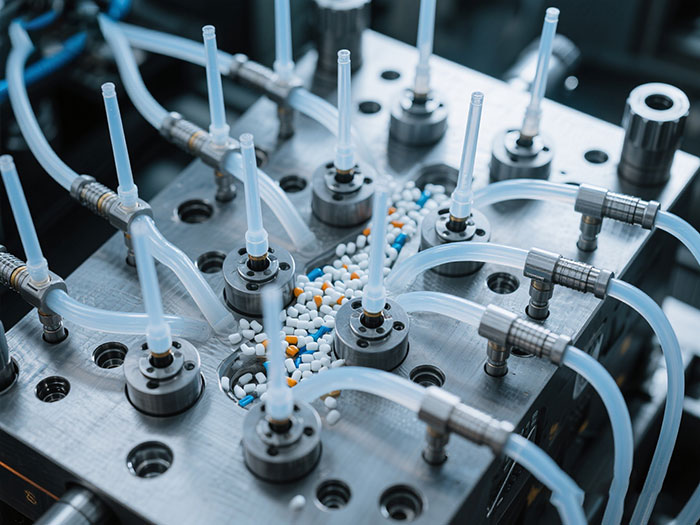When it comes to plastic manufacturing, choosing the right forming process is essential for achievin...
Hot Runner Systems Guide Boost Injection Molding Efficiency
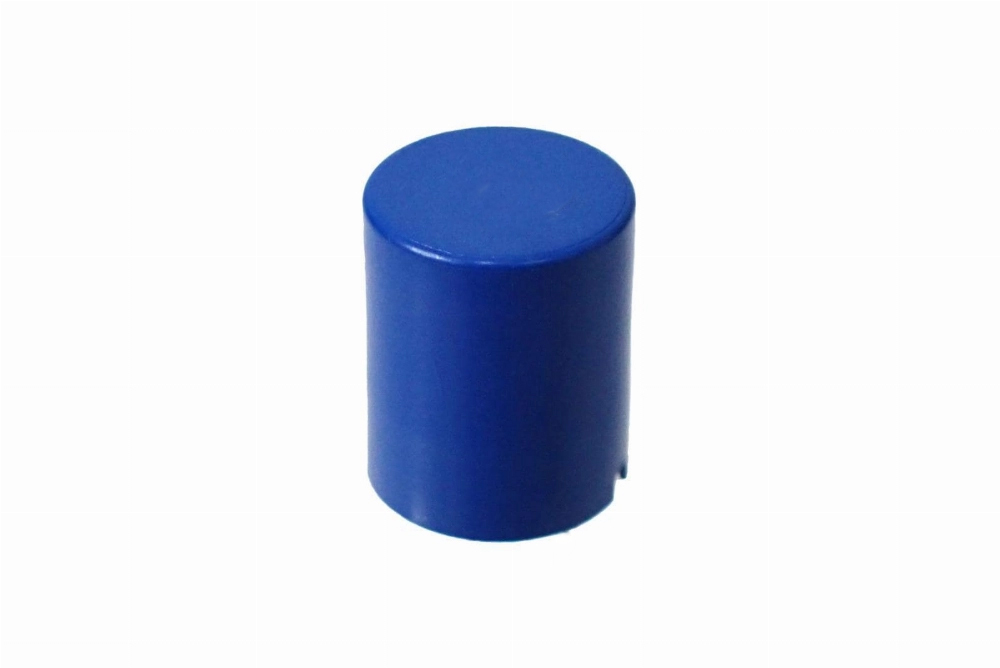
Understanding Hot Runner Systems and Their Efficiency Role
Definition of Hot Runner Systems
A hot runner system is a core temperature control component in injection molding. It uses heating elements (such as manifolds, nozzles, and temperature controllers) to maintain a constant molten plastic temperature from the injection molding machine nozzle to the mold cavity. Compared to traditional cold runners, it does not rely on solidified runners to transport material, ensuring the plastic remains molten.
Core Differences Between Hot Runner and Cold Runner Systems
Cold runner systems use unheated runners to convey plastic. After the melt enters the mold cavity, the runner portion cools and solidifies simultaneously with the finished product, forming waste material that requires separation (commonly referred to as "sprue"). Hot runner systems, conversely, prevent runner solidification via precise temperature control, thereby directly reducing waste generation at its source.
Core Advantages of Hot Runner Systems
1.Reduced Material Waste
Eliminating solidified runner waste significantly improves material utilization, thereby reducing costs and supporting environmental sustainability.
2.Shorter Production Cycle
Eliminating the cooling and cleaning of runners shortens the molding cycle, leading to increased production efficiency.
3.Improved Product Quality
Precise control of melt temperature and flow rate minimizes defects like sink marks and warpage resulting from temperature fluctuations, ensuring consistent batch quality.
Hot runner technology provides a more efficient and sustainable solution for injection molding production by optimizing material flow and thermal management. Understanding its principles and advantages is crucial for manufacturing companies seeking to improve their processes and enhance their market competitiveness.
Key Considerations for Selecting a Hot Runner System
Optimizing injection molding efficiency requires precise matching of the hot runner system. The following are key evaluation factors:
I. Material Compatibility
The hot runner system must be compatible with the plastic's properties.
Temperature-sensitive materials (such as PVC, and POM): require a precise temperature control system to prevent material decomposition;
High-viscosity materials (such as PC): require either higher injection pressure or larger gate sizes;
Typical material adaptation solutions:
Polypropylene (PP): Suitable for conventional runner systems operating at medium temperatures;
Nylon (PA): Requires a high-temperature design and zoned temperature control;
ABS: Suitable for most systems; flow-balancing solutions are preferable.
II. Part Structure Complexity
Mold design directly influences system selection:
Wall thickness differences: Thick-walled parts require valve gates or enlarged gates to ensure filling;
Gate layout: Complex geometric structures require multi-point gate positioning to avoid sink marks and deformation;
Multi-cavity molds: Require flow balancing technology to ensure consistent filling of each cavity.
III. Production Scale and Cost-Effectiveness
Large-scale production: Prioritize hot runner systems to reduce unit costs and improve efficiency;
Small-scale production: Carefully evaluate the economics, considering equipment depreciation and material savings.
IV. Cycle Time Optimization
Runner design: Low-resistance runner designs can shorten filling times;
Temperature control accuracy: Zoned temperature control technology prevents material cooling lag and thermal degradation.
V. System Reliability Management
Maintenance Convenience: A modular design facilitates quick cleaning and component replacement;
Damage-resistant design: Corrosion-resistant runner plates and alloy heating elements prolong service life;
Risk management: Select suppliers offering rapid response capabilities and spare parts support.
Systematic evaluation of these factors can achieve the triple goals of improved production efficiency, reduced waste, and stable quality.
Types of Hot Runner Systems and Their Efficiency Considerations
Hot runner systems, as a core component of the injection molding process, significantly improve production efficiency and material utilization by eliminating the cold runner solidification stage. The selection of different systems directly affects the molding cycle, scrap rate, and product yield. The following is a comparison of the characteristics and efficiency evaluation of three mainstream systems:
1. Hot Nozzle System
Suitable Scenarios: Precision small parts (electronic connectors, micro gears, etc.) and products with high surface requirements
Core Advantages:
No Runner Waste: Direct injection avoids the generation of cold material, increasing material utilization by 15%-30%
Very Short Molding Cycle: Eliminates runner cooling time, shortening the single mold cycle by more than 20%
Dimensional Stability: Multi-point precise temperature control ensures micron-level tolerances
Limitations:
The mold needs to be equipped with a high-precision temperature control module, increasing the initial investment by about 25%
Nozzle diameter limitation (usually <3mm), not suitable for thick-walled or large products
2. Valve-Gated Hot Runner System
Suitable Scenarios: Automotive interior parts, medical catheters, and other multi-cavity complex structure molds.
Key Efficiency Features:
Sequential Control Technology: Precisely controls the opening and closing sequence of each gate through electromagnetic valves, eliminating weld line defects
Mark-Free Surface Finish: Gate vestige height <0.05mm, eliminating the need for post-processing
Supports High-Speed Molding: Enables rapid switching within 3 seconds using a servo-hydraulic system
Key Quality Control Considerations:
Need to periodically calibrate the valve pin stroke (recommended maintenance every 50,000 mold cycles)
Mold temperature fluctuation needs to be controlled within ±1℃, a PID intelligent temperature control box is recommended
3. Open-Type Hot Runner System
Suitable Scenarios: Mass production of single-cavity simple structures such as home appliance housings and daily necessities
Cost Advantages:
Simplified system structure, equipment cost is 40%-50% lower than valve gate type
Convenient maintenance and routine cleaning operations take <2 hours
Efficiency Limitations:
Gate diameter is usually >4mm, sink marks are easily generated on thin-walled parts
Multi-cavity molds need to increase the manifold, which may lead to 15%-20% material redundancy
System Selection Technical Decision Tree
Product Dimension:
Wall thickness <1.5mm → Priority hot nozzle system
A-grade surface finish required → Valve-gated system is mandatory
Annual output >500,000 pieces → Evaluate the ROI of a valve-gated system
Process Parameters:
Melt viscosity >10000Pa·s (such as PC) → Select a high-flow nozzle
Molding cycle <15 seconds → Dynamic temperature control module must be configured
Cost Model:
Using TCO (Total Cost of Ownership) calculation, including:Initial investment difference
Three-year scrap cost (simulated according to resin price fluctuation ±10%)
Production downtime due to preventive maintenance frequency
It is recommended to cooperate deeply with suppliers with CAE mold flow analysis capabilities. Verifying system compatibility in advance using Moldflow simulation can reduce mold trial costs by over 30%.
Step-by-Step Guide to Choosing the Right Hot Runner System
Selecting the right hot runner system is crucial for improving injection molding efficiency and production quality. Here are key steps and optimization recommendations:
Step 1: Part and Mold Requirements Analysis
Part Geometry: Define wall thickness, gate location, and structural complexity to ensure hot runner compatibility.
Mold Type: Distinguish between single-cavity and multi-cavity molds. Multi-cavity molds require attention to runner balance.
Production Goals: High-volume production emphasizes efficiency and stability, while low-volume, high-precision production requires more flexible system configurations.
Step 2: Material and Process Matching
Temperature Sensitivity: High-temperature materials (such as PEEK) require high-temperature resistant components, while general-purpose materials (like PP/ABS) are more adaptable.
Flow Characteristics: Select runner dimensions and temperature control accuracy based on material viscosity to avoid flow restrictions or material degradation.
Processing Parameters: Combine process parameters such as injection pressure and holding pressure time to ensure stable system operation.
Step 3: Flow Analysis and Filling Optimization
Simulation Verification: Predict filling paths through flow analysis software, optimize gate layout, and reduce the risk of short shots or warpages.
Balance Adjustment: For multi-cavity molds, ensure uniform filling across all cavities to prevent increased scrap rates caused by flow variations.
Efficiency Improvement: Balanced filling can shorten cooling time, directly reducing production cycle costs.
Step 4: System Selection and Supplier Evaluation
Hot Tip System (Direct Gate): Suitable for small, precision parts with minimal material waste, but limited control over complex structures.
Valve Gate System: Achieves precise filling through sequential control, suitable for complex or multi-point gate designs, improving surface quality.
Insulated Runner System: Simple structure and low cost, suitable for single-cavity or low-complexity molds.
Supplier Capabilities: Prioritize suppliers with fast technical response and comprehensive after-sales support to ensure long-term maintenance and upgrade needs.
Step 5: Return on Investment (ROI) Calculation
Cost Savings: Hot runners reduce cold runner waste, directly reducing raw material consumption (approximately 15%-30%).
Efficiency Gains: Optimized runner design can shorten the molding cycle by 10%-20%, increasing equipment utilization.
Quality Benefits: Reduce defects like flash and sink marks, decreasing rework and warranty costs.
Core Recommendations
1.Long-Term Perspective: Avoid focusing solely on initial costs; comprehensively evaluate system lifespan and maintenance costs.
2.Temperature Control: Use high-precision temperature control modules to avoid material thermal decomposition or flow fluctuations.
3.Regular Maintenance: Clean runners and replace seals to extend system lifespan.
4.Data-Driven: Continuously optimize process parameters through production data to maximize hot runner performance.
By using this guide, companies can choose the right hot runner system, and significantly improve production efficiency and cost-effectiveness, while reducing plastic waste and energy consumption.
Common Mistakes to Avoid When Choosing a Hot Runner System
1. Ignoring Material Properties and Process Matching
Core Issue: Failure to select a suitable system based on material properties (such as thermal stability, flow rate, viscosity).
Risk Example: High-temperature resins (such as PEEK) require a precise temperature control system, and low-viscosity materials (such as PP) require highly responsive flow control. If the system is improperly matched, it can easily lead to degradation, flash, or uneven filling.
Solution: Consult material property data sheets and supplier technical parameters, and prioritize systems with temperature control accuracy within ±1°C and flow channel designs that match the viscosity curve.
2. Sacrificing Performance in the Eager Pursuit of Low Prices
Hidden Costs: Low-priced systems often have problems such as poor thermal balance and short component life. In the long run, maintenance downtime and increased scrap rates can increase costs.
Decision Basis: Use a Total Cost of Ownership (TCO) evaluation model, incorporating energy efficiency (such as heating power optimization), maintenance cycles (such as nozzle replacement frequency), and potential for increased yield.
Practical Advice: When comparing suppliers, ask them to provide failure rate data and energy consumption reports from relevant case studies.
3. Underestimating the Technical Threshold for System Maintenance
Typical Misconception: Believing that "maintenance-free" systems exist, or overlooking ease of cleaning and part replacement.
Consequences: Insufficient cleaning of complex runner structures can lead to carbonized residue and batch quality issues.
Optimization Direction:
Choose a modular design system to ensure that the vulnerable parts such as heaters and thermocouples can be quickly replaced;
Develop a preventive maintenance plan (such as comprehensive leak testing after every 50,000 cycles);
Require suppliers to provide standardized operational training and remote diagnostic support.
Key Decision Logic: Identify high-risk areas through DFMEA (a Failure Mode and Effects Analysis), and prioritize suppliers with material databases, simulation support, and local service networks to avoid selection errors early on.
How Hot Runner Systems Enhance Injection Molding Production Efficiency
Hot runner systems significantly optimize production processes, a core technology in modern injection molding. The efficiency improvement is mainly reflected in the following three core dimensions:
I. Revolutionary Breakthrough in Material Utilization
Zero-Waste Runner Design: Unlike the sprue and runner scrap generated by cold runner systems, hot runners maintain the plastic in a molten state throughout the process through precise temperature control, achieving material utilization that reaches 100%.
Significant Cost Reduction and Efficiency Improvement: With a daily production volume of 100,000 units, several tons of raw material waste can be reduced annually, reducing material costs by 15%-25% in mass production.
Green Manufacturing Advantages: Reduced waste disposal, meeting environmental policy requirements, and helping companies achieve carbon neutrality goals.
II. Dual-Engine Driven Production Cycle Optimization
Improved Cooling Efficiency
The constant temperature system avoids secondary heating of cold runners and coupled with rapid mold cooling technology, single cycle time can be shortened by 20%-40%.Deep Integration of Automation
Enables automated continuous production with robotic assistance for:Automated mold opening and closing
Automatic product removal
Real-time in-mold quality monitoring Daily production output can be increased by over 30%
III. Quality Control System Upgrade
| Quality Indicators | Performance Improvement | Underlying Technology |
|---|---|---|
| Dimensional Stability | Tolerance control accuracy increased by 40% | Balanced runner pressure control system |
| Surface Quality | Occurrence rate of flow marks/shrink marks reduced by 60% | Multi-stage temperature zone control technology |
| Structural Integrity | The deformation rate due to internal stress decreased by 50% | Valve gate sequential control technology |
Synergistic Efficiency Mechanism:
Optimized hot nozzle layout through mold flow analysis software, combined with PID intelligent temperature control module (accuracy ±0.5℃), for synchronized melt flow front control. Combined with servo valve gate system, achieving timing precision down to 0.02 seconds, ensuring filling consistency of multi-cavity molds.
Advanced Application Scenarios
Micro-Precision Part Production: Achieves a 99.5% yield for parts with wall thicknesses below 0.3mm.
Multi-Layer Composite Molds: Maintains temperature variation within ±1.5℃ for molds with 16 or more cavities.
Engineering Plastic Processing: Suitable for stable molding of high-viscosity materials such as PA and PEEK.
After introducing hot runner systems, companies can typically recover investment costs within 6-18 months through material savings and increased throughput. With the increasing adoption of intelligent temperature control and IoT-based remote monitoring systems, hot runner systems are evolving from simple efficiency tools to integral components of smart manufacturing.
